Sea Life Relax Wiki : Atlantic
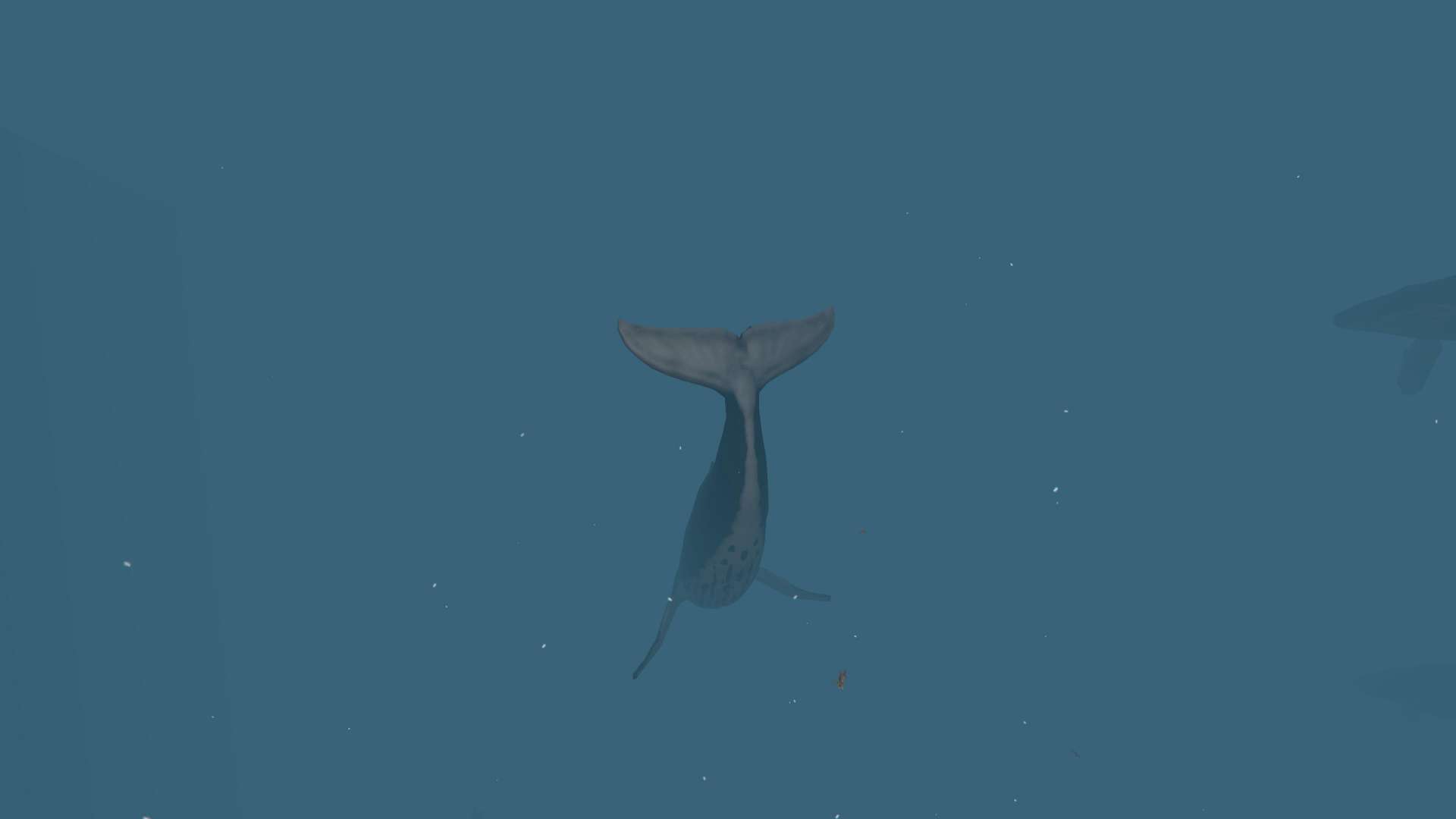
The 2nd largest ocean on our planet, a little sample of the wildlife of this ocean is visible in Sea Life Relax. You will be able to admire species sometimes little known, sometimes rare, and others majestic. This long shape environment gives you the prospect of an ocean. This is one of the most populated environments in the entire app, there is something to see everywhere and of all sizes.
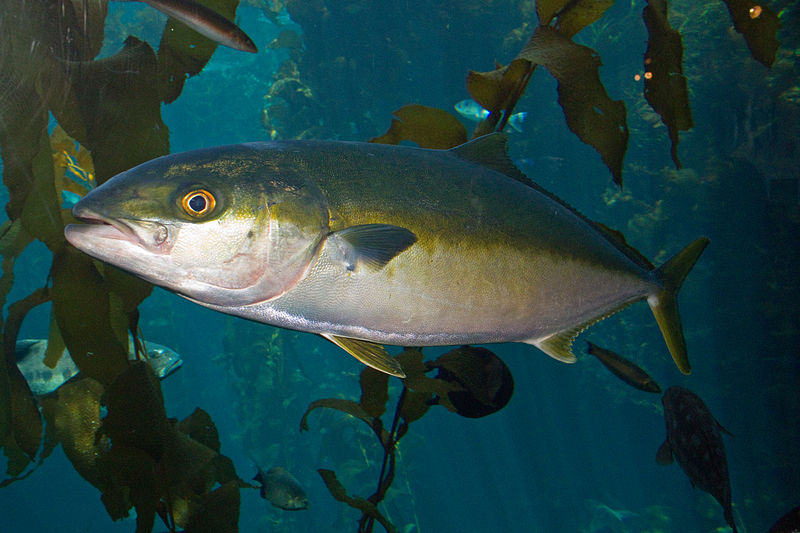
Amberjack
Amberjack is an Atlantic and Pacific fish of the Carangidae family (genus Seriola). They are a game fish, most often found in the warmer parts of ocean. There are many variations of Amberjack, including Greater Amberjack (Atlantic), Lesser Amberjack (Atlantic), Almaco Jack (Pacific), yellowtail (Pacific), and the Banded Rubberfish (Atlantic).
Wikipedia

Bass
Bass (/bæs/) is a name shared by many species of fish. The term encompasses both freshwater and marine species, all belonging to the large order Perciformes, or perch-like fishes. The word bass comes from Middle English bars, meaning "perch".
Wikipedia
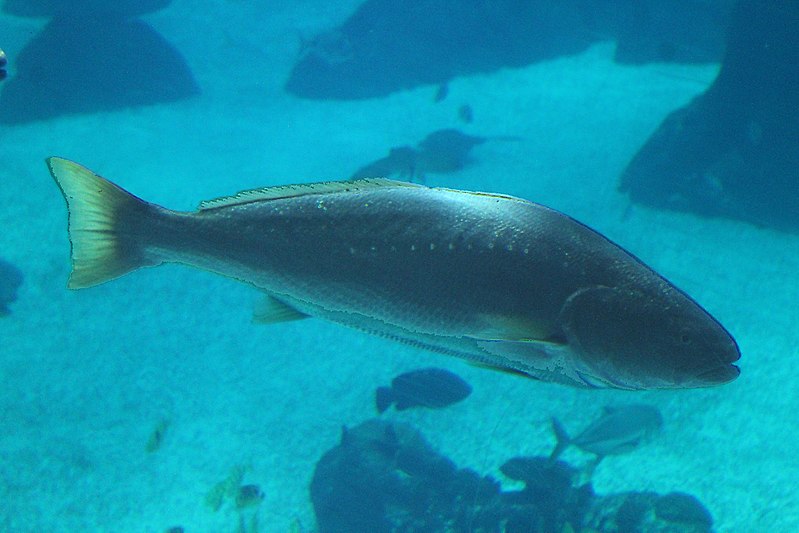
Atlantic Cod
The Atlantic cod (Gadus morhua) is a benthopelagic fish of the family Gadidae, widely consumed by humans. It is also commercially known as cod or codling.[2][n 1] Dry cod may be prepared as unsalted stockfish,[3][9][n 2] as cured salt cod or clipfish.
In the western Atlantic Ocean, cod has a distribution north of Cape Hatteras, North Carolina, and around both coasts of Greenland and the Labrador Sea; in the eastern Atlantic, it is found from the Bay of Biscay north to the Arctic Ocean, including the Baltic Sea, the North Sea, Sea of the Hebrides,[13] areas around Iceland and the Barents Sea.
The largest individual on record was 6 feet (1.8 m) long and weighed 211 lb (96 kg), however usually the cod is between 24 inches (61 cm) and 4 feet (1.2 m) long, and weighs up to 88 lb (40 kg). There is generally no difference in weight or size between sexes of Atlantic Cod.
Atlantic Cod can live for 25 years, and usually attain sexual maturity between ages two and four, although cod in the northeast Arctic can take as long as eight years to fully mature. Colouring is brown or green, with spots on the dorsal side, shading to silver ventrally. A stripe along its lateral line (used to detect vibrations) is clearly visible. Its habitat ranges from the shoreline down to the continental shelf.
Several cod stocks collapsed in the 1990s (declined by >95% of maximum historical biomass) and have failed to fully recover even with the cessation of fishing. This absence of the apex predator has led to a trophic cascade in many areas. Many other cod stocks remain at risk. The Atlantic cod is labelled vulnerable on the IUCN Red List of Threatened Species. Lien Wikipédia
In the western Atlantic Ocean, cod has a distribution north of Cape Hatteras, North Carolina, and around both coasts of Greenland and the Labrador Sea; in the eastern Atlantic, it is found from the Bay of Biscay north to the Arctic Ocean, including the Baltic Sea, the North Sea, Sea of the Hebrides,[13] areas around Iceland and the Barents Sea.
The largest individual on record was 6 feet (1.8 m) long and weighed 211 lb (96 kg), however usually the cod is between 24 inches (61 cm) and 4 feet (1.2 m) long, and weighs up to 88 lb (40 kg). There is generally no difference in weight or size between sexes of Atlantic Cod.
Atlantic Cod can live for 25 years, and usually attain sexual maturity between ages two and four, although cod in the northeast Arctic can take as long as eight years to fully mature. Colouring is brown or green, with spots on the dorsal side, shading to silver ventrally. A stripe along its lateral line (used to detect vibrations) is clearly visible. Its habitat ranges from the shoreline down to the continental shelf.
Several cod stocks collapsed in the 1990s (declined by >95% of maximum historical biomass) and have failed to fully recover even with the cessation of fishing. This absence of the apex predator has led to a trophic cascade in many areas. Many other cod stocks remain at risk. The Atlantic cod is labelled vulnerable on the IUCN Red List of Threatened Species. Lien Wikipédia

Butterflyfish
The butterflyfish are a group of conspicuous tropical marine fish of the family Chaetodontidae; the bannerfish and coralfish are also included in this group. The approximately 129 species in 12 genera are found mostly on the reefs of the Atlantic, Indian, and Pacific Oceans. A number of species pairs occur in the Indian and Pacific Oceans, members of the huge genus Chaetodon.
Butterflyfish look like smaller versions of angelfish (Pomacanthidae), but unlike these, lack preopercle spines at the gill covers. Some members of the genus Heniochus resemble the Moorish idol (Zanclus cornutus) of the monotypic Zanclidae. Among the paraphyletic Perciformes, the former are probably not too distantly related to butterflyfish, whereas the Zanclidae seem far less close. Wikipedia
Butterflyfish look like smaller versions of angelfish (Pomacanthidae), but unlike these, lack preopercle spines at the gill covers. Some members of the genus Heniochus resemble the Moorish idol (Zanclus cornutus) of the monotypic Zanclidae. Among the paraphyletic Perciformes, the former are probably not too distantly related to butterflyfish, whereas the Zanclidae seem far less close. Wikipedia
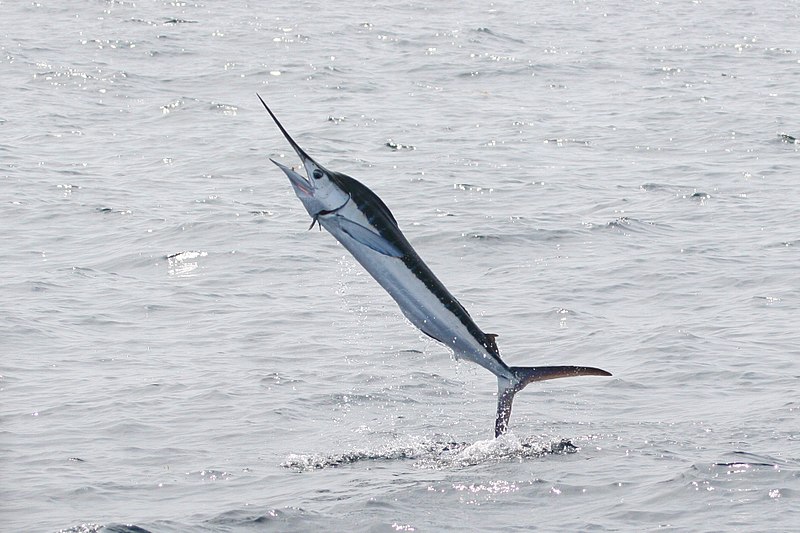
Blue marlin
A marlin is a fish from the family Istiophoridae, which includes about 10 species. It has an elongated body, a spear-like snout or bill, and a long, rigid dorsal fin which extends forward to form a crest. Its common name is thought to derive from its resemblance to a sailor's marlinspike. Even more so than their close relatives, the scombrids, marlins are fast swimmers, reaching speeds of about 80 km/h (50 mph).
The larger species include the Atlantic blue marlin, Makaira nigricans, which can reach 5 m (16.4 ft) in length and 818 kg (1,803 lb) in weight[3] and the black marlin, Istiompax indica, which can reach in excess of 5 m (16.4 ft) in length and 670 kg (1,480 lb) in weight. They are popular sporting fish in tropical areas. Lien Wikipédia
The larger species include the Atlantic blue marlin, Makaira nigricans, which can reach 5 m (16.4 ft) in length and 818 kg (1,803 lb) in weight[3] and the black marlin, Istiompax indica, which can reach in excess of 5 m (16.4 ft) in length and 670 kg (1,480 lb) in weight. They are popular sporting fish in tropical areas. Lien Wikipédia
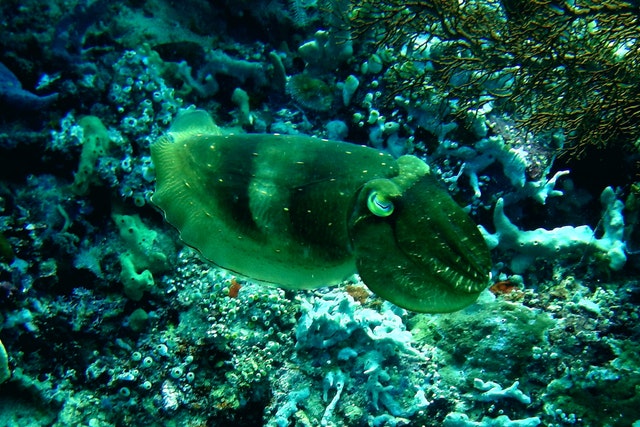
Cuttlefish
Cuttlefish or cuttles are marine animals of the order Sepiida. They belong to the class Cephalopoda, which also includes squid, octopuses, and nautiluses. Cuttlefish have a unique internal shell, the cuttlebone. Despite their name, cuttlefish are not fish but molluscs.
Cuttlefish have large, W-shaped pupils, eight arms, and two tentacles furnished with denticulated suckers, with which they secure their prey. They generally range in size from 15 to 25 cm (6 to 10 in), with the largest species, Sepia apama, reaching 50 cm (20 in) in mantle length and over 10.5 kg (23 lb) in mass.
Cuttlefish eat small molluscs, crabs, shrimp, fish, octopus, worms, and other cuttlefish. Their predators include dolphins, sharks, fish, seals, seabirds, and other cuttlefish. The average life expectancy of a cuttlefish is about one to two years. Recent studies indicate cuttlefish are among the most intelligent invertebrates.
Cuttlefish also have one of the largest brain-to-body size ratios of all invertebrates.
The 'cuttle' in 'cuttlefish' comes from the Old English name for the species, cudele, which may be cognate with the Old Norse koddi ('cushion') and the Middle Low German Kudel ('rag'). The Greco-Roman world valued the cuttlefish as a source of the unique brown pigment the creature releases from its siphon when it is alarmed. The word for it in both Greek and Latin, sepia, now refers to the reddish-brown color sepia in English. Lien Wikipédia
Cuttlefish have large, W-shaped pupils, eight arms, and two tentacles furnished with denticulated suckers, with which they secure their prey. They generally range in size from 15 to 25 cm (6 to 10 in), with the largest species, Sepia apama, reaching 50 cm (20 in) in mantle length and over 10.5 kg (23 lb) in mass.
Cuttlefish eat small molluscs, crabs, shrimp, fish, octopus, worms, and other cuttlefish. Their predators include dolphins, sharks, fish, seals, seabirds, and other cuttlefish. The average life expectancy of a cuttlefish is about one to two years. Recent studies indicate cuttlefish are among the most intelligent invertebrates.
Cuttlefish also have one of the largest brain-to-body size ratios of all invertebrates.
The 'cuttle' in 'cuttlefish' comes from the Old English name for the species, cudele, which may be cognate with the Old Norse koddi ('cushion') and the Middle Low German Kudel ('rag'). The Greco-Roman world valued the cuttlefish as a source of the unique brown pigment the creature releases from its siphon when it is alarmed. The word for it in both Greek and Latin, sepia, now refers to the reddish-brown color sepia in English. Lien Wikipédia
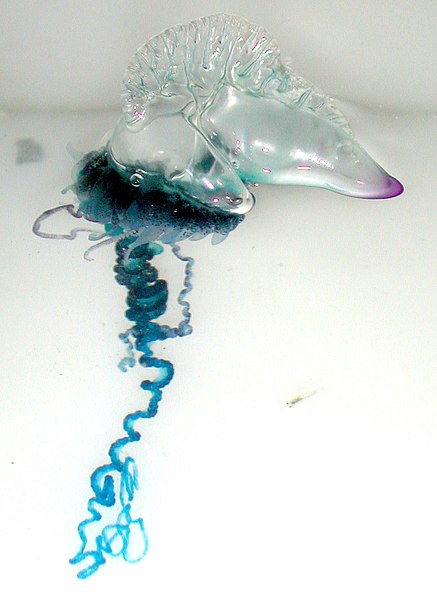
Portuguese man o' war
The Atlantic Portuguese man o' war (Physalia physalis), also known as the man-of-war, is a marine hydrozoan of the family Physaliidae found in the Atlantic, Indian and Pacific Oceans. Its long tentacles deliver a painful sting, which is venomous and powerful enough to kill fish or (rarely) humans. Despite its appearance, the Portuguese man o' war is not a true jellyfish but a siphonophore, which is not actually a single multicellular organism (true jellyfish are single organisms), but a colonial organism made up of specialized individual animals (of the same species) called zooids or polyps. These polyps are attached to one another and physiologically integrated, to the extent that they cannot survive independently, creating a symbiotic relationship, requiring each polyp to work together and function like an individual animal.
The Indo-Pacific Portuguese man-of-war (P. utriculus), or blue bottle, is a related species with very similar appearance found throughout the Indian and Pacific Oceans. Lien Wikipédia
The Indo-Pacific Portuguese man-of-war (P. utriculus), or blue bottle, is a related species with very similar appearance found throughout the Indian and Pacific Oceans. Lien Wikipédia

Stingray
Stingrays are a group of sea rays, which are cartilaginous fish related to sharks. They are classified in the suborder Myliobatoidei of the order Myliobatiformes and consist of eight families: Hexatrygonidae (sixgill stingray), Plesiobatidae (deepwater stingray), Urolophidae (stingarees), Urotrygonidae (round rays), Dasyatidae (whiptail stingrays), Potamotrygonidae (river stingrays), Gymnuridae (butterfly rays), and Myliobatidae (eagle rays).
Stingrays are common in coastal tropical and subtropical marine waters throughout the world. Some species, such as Dasyatis thetidis, are found in warmer temperate oceans, and others, such as Plesiobatis daviesi, are found in the deep ocean. The river stingrays, and a number of whiptail stingrays (such as the Niger stingray), are restricted to fresh water. Most myliobatoids are demersal (inhabiting the next-to-lowest zone in the water column), but some, such as the pelagic stingray and the eagle rays, are pelagic.
There are about 220 known stingray species organized into 10 families and 29 genera. Stingray species are progressively becoming threatened or vulnerable to extinction, particularly as the consequence of unregulated fishing. As of 2013, 45 species have been listed as vulnerable or endangered by the IUCN. The status of some other species is poorly known, leading to their being listed as data deficient.
Lien Wikipédia
Stingrays are common in coastal tropical and subtropical marine waters throughout the world. Some species, such as Dasyatis thetidis, are found in warmer temperate oceans, and others, such as Plesiobatis daviesi, are found in the deep ocean. The river stingrays, and a number of whiptail stingrays (such as the Niger stingray), are restricted to fresh water. Most myliobatoids are demersal (inhabiting the next-to-lowest zone in the water column), but some, such as the pelagic stingray and the eagle rays, are pelagic.
There are about 220 known stingray species organized into 10 families and 29 genera. Stingray species are progressively becoming threatened or vulnerable to extinction, particularly as the consequence of unregulated fishing. As of 2013, 45 species have been listed as vulnerable or endangered by the IUCN. The status of some other species is poorly known, leading to their being listed as data deficient.
Lien Wikipédia
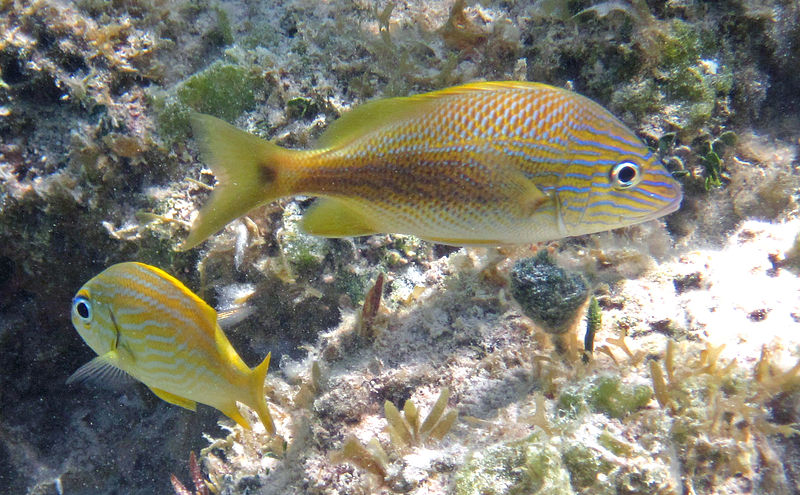
Haemulon plumierii
Haemulon plumierii, the white grunt or common grunt, is a species of ray-finned fish in the family Haemulidae native to the western Atlantic Ocean. It grows to a length of about 30 cm (12 in) and is a silvery-cream color, with narrow yellow and blue longitudinal stripes, but can modify its color somewhat to match its surroundings. It is closely related to the blue striped grunt and the French grunt and often schools with these species. It feeds on shrimp, other crustaceans, annelids and mollusks, and is preyed on by larger piscivores such as barracuda and shark. It is sometimes caught by anglers as a game fish and its white flesh can be eaten. It is also a popular aquarium fish.
Wikipedia
Wikipedia
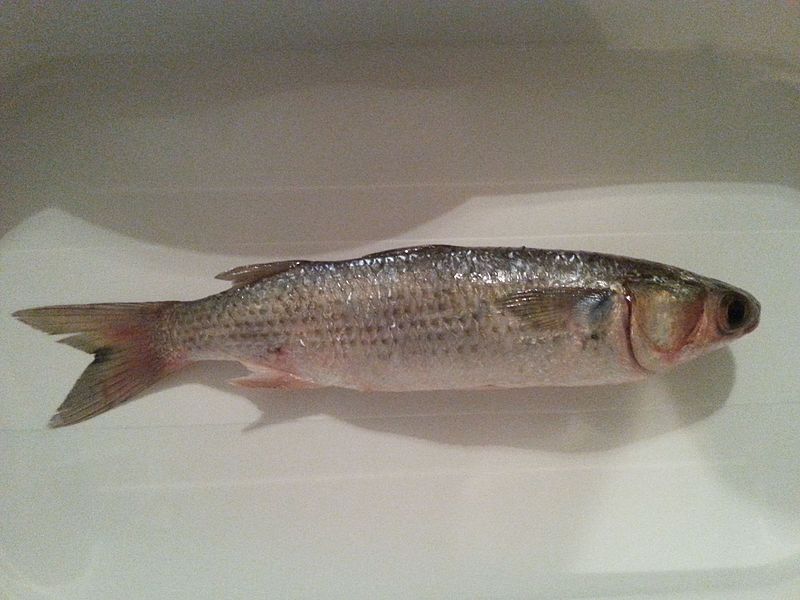
White mullet
The white mullet or silver mullet (Mugil curema) is a (sub)tropical marine fish of the family Mugilidae. It is commonly about 30 cm long.
Note that silver mullet is also a common name used for fantail mullet (Mugil gyrans).
Wikipedia
Wikipedia
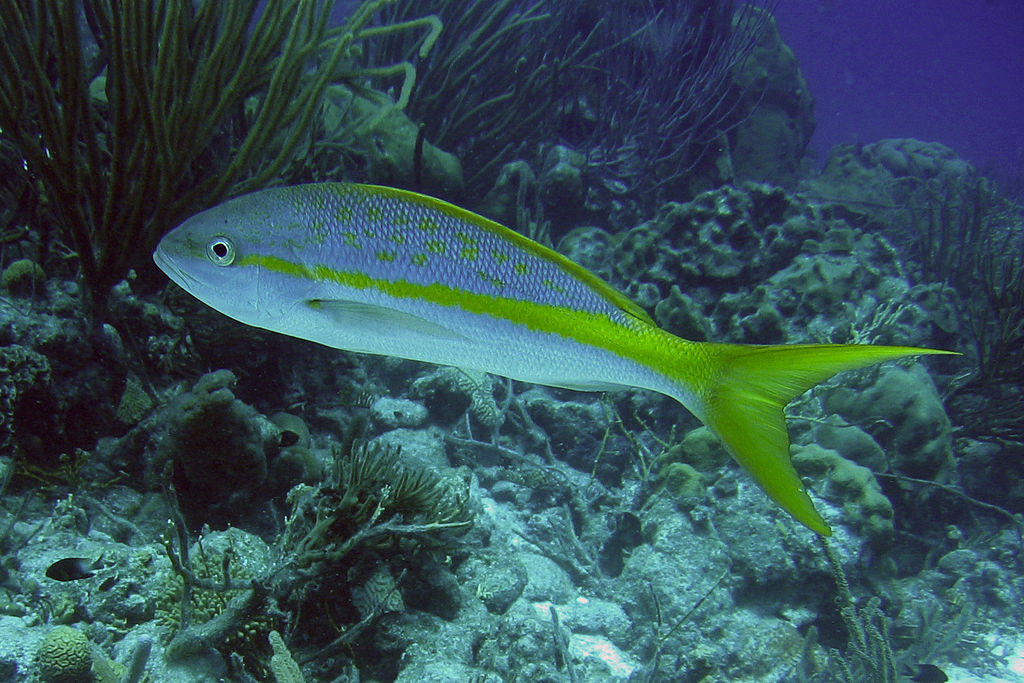
Yellowtail snapper
The yellowtail snapper (Ocyurus chrysurus) is an abundant species of snapper native to the western Atlantic Ocean including the Gulf of Mexico and the Caribbean Sea. Although they have been found as far north as Massachusetts, their normal range is along Florida south to the West Indies and Brazil. This species is mostly found around coral reefs, but may be found in other habitats. They occur at depths of from near the surface to 180 metres (590 ft), though mostly between 10 and 70 m (33 and 230 ft). This species can reach a length of 86.3 cm (34.0 in), though most do not exceed 40 cm (16 in). The greatest weight recorded for this species is 4.1 kg (9.0 lb). It is a commercially important species and has been farmed. It is sought as a game fish by recreational anglers and is a popular species for display in public aquaria. This species is the only known member of its genus.
In certain reefs, most notably in the Florida Keys, this beautifully colored fish is commonly spotted among divers and snorkelers. Yellowtails feed on shrimp, crabs, worms, and smaller fish. They spawn in groups off the edges of reefs from spring to fall, but heavily in midsummer.
Yellowtail snapper are typically caught in 30–120 ft of water on and around reefs and other structure. The most common method of catching them is with hook and line, and the use of frozen chum, typically leftover ground fish parts, to attract the fish. The chum is placed into a mesh bag or metal basket in the water, and as the chum slowly melts, small pieces of fish drift out and down towards the bottom, where the yellowtails typically feed. The chum keeps them near the boat for extended periods of time, as well. Light tackle is the generally accepted means of catching yellowtail snapper. Typically, the fish are relatively wary of higher-test or thicker line, and larger hooks. Most fish caught by anglers range from eight to 14 in, although catches to 16 in are not uncommon. Yellowtail snapper can be caught on a variety of baits, including both live and frozen shrimp, squid, and a variety of live and frozen minnows or smaller baitfish. Yellowtail tend to be wary fish, and the appearance of larger predators, such as dolphins or sharks, can scare off schools until the predator leaves the area.
Wikipedia
In certain reefs, most notably in the Florida Keys, this beautifully colored fish is commonly spotted among divers and snorkelers. Yellowtails feed on shrimp, crabs, worms, and smaller fish. They spawn in groups off the edges of reefs from spring to fall, but heavily in midsummer.
Yellowtail snapper are typically caught in 30–120 ft of water on and around reefs and other structure. The most common method of catching them is with hook and line, and the use of frozen chum, typically leftover ground fish parts, to attract the fish. The chum is placed into a mesh bag or metal basket in the water, and as the chum slowly melts, small pieces of fish drift out and down towards the bottom, where the yellowtails typically feed. The chum keeps them near the boat for extended periods of time, as well. Light tackle is the generally accepted means of catching yellowtail snapper. Typically, the fish are relatively wary of higher-test or thicker line, and larger hooks. Most fish caught by anglers range from eight to 14 in, although catches to 16 in are not uncommon. Yellowtail snapper can be caught on a variety of baits, including both live and frozen shrimp, squid, and a variety of live and frozen minnows or smaller baitfish. Yellowtail tend to be wary fish, and the appearance of larger predators, such as dolphins or sharks, can scare off schools until the predator leaves the area.
Wikipedia
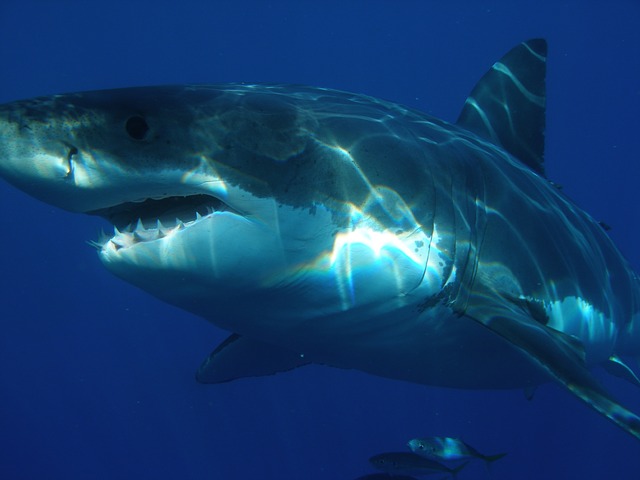
Great White Shark
The great white shark (Carcharodon carcharias), also known as the great white, white shark or white pointer, is a species of large mackerel shark which can be found in the coastal surface waters of all the major oceans. The great white shark is notable for its size, with larger female individuals growing to 6.1 m (20 ft) in length and 1,905 kg (4,200 lb) in weight at maturity.
However most are smaller, males measuring 3.4 to 4.0 m (11 to 13 ft) and females 4.6 to 4.9 m (15 to 16 ft) on average. According to a 2014 study the lifespan of great white sharks is estimated to be as long as 70 years or more, well above previous estimates, making it one of the longest lived cartilaginous fish currently known. According to the same study, male great white sharks take 26 years to reach sexual maturity, while the females take 33 years to be ready to produce offspring. Great white sharks can swim at speeds of over 56 km/h (35 mph), and can swim to depths of 1,200 m (3,900 ft).
The great white shark has no known natural predators other than, on very rare occasions, the killer whale. The great white shark is arguably the world's largest known extant macropredatory fish, and is one of the primary predators of marine mammals. It is also known to prey upon a variety of other marine animals, including fish and seabirds. It is the only known surviving species of its genus Carcharodon, and is responsible for more recorded human bite incidents than any other shark.
The species faces numerous ecological challenges which has resulted in international protection. The IUCN lists the great white shark as a vulnerable species, and it is included in Appendix II of CITES. It is also protected by several national governments such as Australia (as of 2018).
The novel Jaws by Peter Benchley and the subsequent film by Steven Spielberg depicted the great white shark as a "ferocious man eater". Humans are not the preferred prey of the great white shark, but, nevertheless, the great white is responsible for the largest number of reported and identified fatal unprovoked shark attacks on humans. The great white shark has also been called the white death.
Wikipedia
However most are smaller, males measuring 3.4 to 4.0 m (11 to 13 ft) and females 4.6 to 4.9 m (15 to 16 ft) on average. According to a 2014 study the lifespan of great white sharks is estimated to be as long as 70 years or more, well above previous estimates, making it one of the longest lived cartilaginous fish currently known. According to the same study, male great white sharks take 26 years to reach sexual maturity, while the females take 33 years to be ready to produce offspring. Great white sharks can swim at speeds of over 56 km/h (35 mph), and can swim to depths of 1,200 m (3,900 ft).
The great white shark has no known natural predators other than, on very rare occasions, the killer whale. The great white shark is arguably the world's largest known extant macropredatory fish, and is one of the primary predators of marine mammals. It is also known to prey upon a variety of other marine animals, including fish and seabirds. It is the only known surviving species of its genus Carcharodon, and is responsible for more recorded human bite incidents than any other shark.
The species faces numerous ecological challenges which has resulted in international protection. The IUCN lists the great white shark as a vulnerable species, and it is included in Appendix II of CITES. It is also protected by several national governments such as Australia (as of 2018).
The novel Jaws by Peter Benchley and the subsequent film by Steven Spielberg depicted the great white shark as a "ferocious man eater". Humans are not the preferred prey of the great white shark, but, nevertheless, the great white is responsible for the largest number of reported and identified fatal unprovoked shark attacks on humans. The great white shark has also been called the white death.
Wikipedia
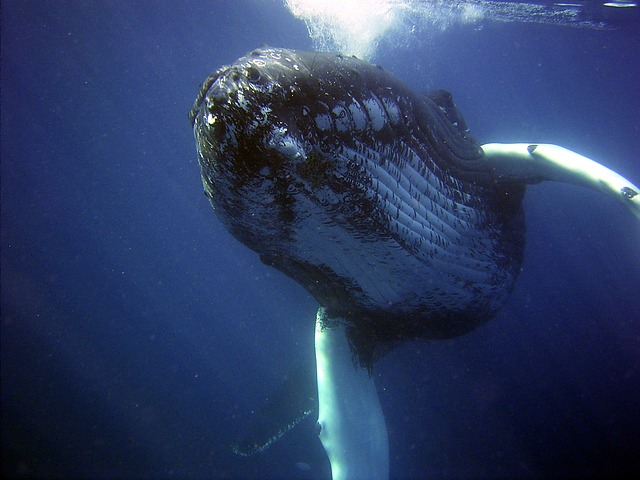
Humpback whale
The humpback whale (Megaptera novaeangliae) is a species of baleen whale. One of the larger rorqual species, adults range in length from 12–16 m (39–52 ft) and weigh around 25–30 metric tons (28–33 short tons). The humpback has a distinctive body shape, with long pectoral fins and a knobbly head. It is known for breaching and other distinctive surface behaviors, making it popular with whale watchers. Males produce a complex song lasting 10 to 20 minutes, which they repeat for hours at a time. Its purpose is not clear, though it may have a role in mating.
Found in oceans and seas around the world, humpback whales typically migrate up to 25,000 km (16,000 mi) each year. They feed in polar waters, and migrate to tropical or subtropical waters to breed and give birth, fasting and living off their fat reserves. Their diet consists mostly of krill and small fish. Humpbacks have a diverse repertoire of feeding methods, including the bubble net technique.
Like other large whales, the humpback was a target for the whaling industry. Once hunted to the brink of extinction, its population fell by an estimated 90% before a 1966 moratorium. While stocks have partially recovered to some 80,000 animals worldwide, entanglement in fishing gear, collisions with ships and noise pollution continue to impact the species.
Lien Wikipédia
Found in oceans and seas around the world, humpback whales typically migrate up to 25,000 km (16,000 mi) each year. They feed in polar waters, and migrate to tropical or subtropical waters to breed and give birth, fasting and living off their fat reserves. Their diet consists mostly of krill and small fish. Humpbacks have a diverse repertoire of feeding methods, including the bubble net technique.
Like other large whales, the humpback was a target for the whaling industry. Once hunted to the brink of extinction, its population fell by an estimated 90% before a 1966 moratorium. While stocks have partially recovered to some 80,000 animals worldwide, entanglement in fishing gear, collisions with ships and noise pollution continue to impact the species.
Lien Wikipédia
